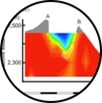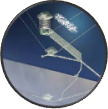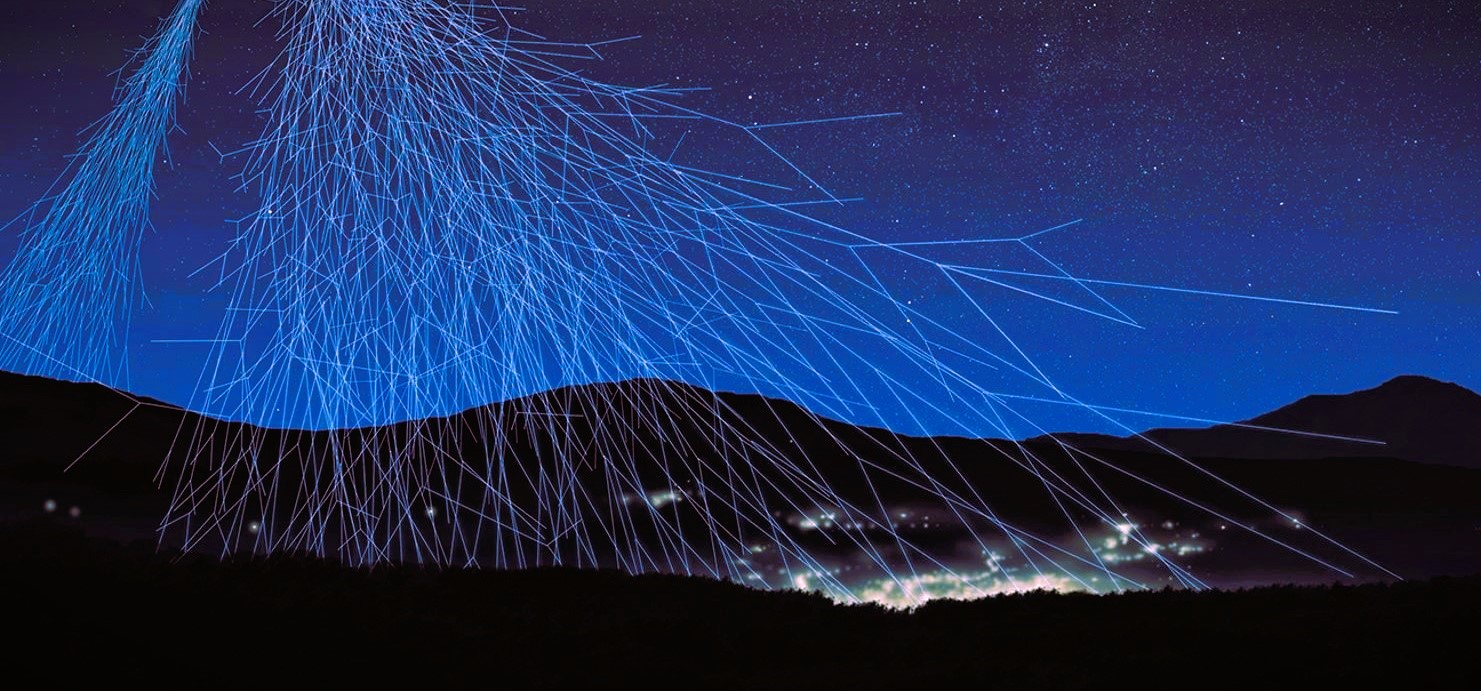The technique now known as muography results from a series of discoveries, experiments and technological developments of the last decades.
A selection of some of the important events, pioreering works and examples of the application of muons is here presented in a chronological order.
1912

The discovery of Cosmic Rays
The Austrian physicist, Victor Hess, discovers the cosmic rays in a series of hot air balloon rises, while looking for the source of the ionization radiation observed from the ground and atmosphere. The highest altitude reached was 5.3 km. In 1936 he is awarded the Nobel prize for the discovery.
1933

First Observation of a Muon
The first evidence of the existence of muons was obtained by Paul Kunze in a Wilson Cloud Chamber exposed to cosmic rays. At the time, however, it was not clear what this particle was. It was classified as an unknown product of a nuclear reaction.
1936

Definite Discovery of Muons
This was the year in which the American physicist Carl Anderson and his student Seth Neddermeyer, definitely discovered muons. Again they observed muons produced by cosmic rays. This was the first of many of new subatomic particles that would be discovered in the following years.
1950s

First Generation of Particle Accelerators
This decade saw the birth of the first generation of particle accelerators, which speed up the advances on the scientific knowledge about muons and their applications. One of the first accelerators was the Synchrocyclotron at CERN..
1955

First Application of Cosmic Muons
The first record of an application of muons produced by cosmic rays was their use by Eric George to measure the ice thickness above a tunnel in Australia. A Geiger counter was used to measure the ionization produced by the muons.
1969

Muon Radiography at the Pyramid of Khafre
Muon radiography is used by the team of Luis Alvarez to search for hidden chambers in the Pyramid of Khafre in Egypt. The detection was done with Spark Chambers and Scintilator Counters. No hidden chamber was found at that moment.
1987

Measurement of the Depth of the Nagoya Underground
This year, the muons were used to measure the depth of the tunnels of the underground system in Nagoya (Japan). The detectors used were based on Scintillation Counters.
1999

Moon Shadow Seen with Muons
The Soudan II detector, located at a depth of 700 m underground in Minnesota (USA), measured the muon flux, observing the shadow of the Moon, that blocks cosmic rays that would come from that direction.
2003

Inspection of the Sun Pyramid
Preparations start for inspecting the interior of the Sun Pyramid in Mexico, following the measurements of Luis Alvarez in Egypt. The muon detection system uses Scintillator Counters and Multi Wire Proportional Chambers.

First Application of Muon Scattering Tomography
At the Los Alamos National Laboratory, a pioneering work uses Coulomb scattering of muons to identify highly charged atomic nuclei, to detect of nuclear materials. A real size scanner to observe containers in transport trucks was installed at Freeport (in Bahamas).
2007

Density measurement of Mount Asama and the Showa-Shinzan dome
Muon radiography is used to measure the average density profile of Mount Asama and the Showa-Shinzan dome, in Japan. The detection system is based on Emulsion Cloud Chambers. This was the first application of muon tomography to geological structures like volcanoes.
2008

Telescope for Muon Scattering Tomography at LNL
The use muon scattering tomography to detect materials with high atomic number was tested by the Legnaro National Labotratory in Italy, where a prototype telescope was constructed and a functional vehicle was tested. The car battery, which contains lead, was the element mostly shown in the image, showing the viability of the technique.
2009

The Muon Tomography Systema at INFN
The large-volume muon tomography system, built by the National Institute of Nuclear Physics of Italy, demonstrates the possibility of differentiating between different materials. The system is based on chambers sensitive to muon scattering.

Volcano Inner Density Profile
The density profile inside a volcano in Japan is obtained by combining the cosmic ray muography and the classical method of gravimetry. The results show the success that can be achieved by combining both techniques which are directly sensitive to the density of the observed materials.
2012

Simulation of the Nuclear Power Plant of Fukushima-Daiichi
Simulation studies show the viability of identifying voids and the movement of materials by using muon tomography to image the core of the nuclear reactor after the accident of the nuclear power plant at Fukushima-Daiichi.
2013

Study of the Structure of the Puy de Dôme
Muon transmission tomography was used to study the interior of the volcanic dome of Puy de Dôme, in France. Athe muon radiographies can be correlated to the geology and specific geological structures that can be observed locally.

Muon Tomography in Mars
A group at the Caltech (USA) proposed to use muon tomography to map the terrain in Mars. The studies show that the muon flux present in the atmosphere of Mars is of the same order of magnitude than the muon flux in the Earth atmosphere. Rovers equipped with muographic systems could then be used to observe the geological structures found at the surface of Mars from their interior.
2014

Monitoring of Palazzo della Loggia
A monitoring system based on muon tomography is installed at Palazzo della Loggia, in Italy, to monitor the stability of the historical building, dating from 1574. The technique allows for the detection of small deformations in the building structure.

Nuclear Waste Control
The first images of the inside of nuclear waste containers were obtained by the Sellafield Muon Tomography project using small scale detector prototypes in Glasgow, UK. The high resolutions achieved allows to verify the integrity of the full container and to identify the different components based on their density.
2016

WatTo Experiment
A muon transmission tomography telescope was pointed to observe a water tower in Saclay, France. The goal is to detect density variations inside the tower, corresponding to the changes in the water levels. The observed muon flux decreases with higher water level and increases for lower water levels.
2017

ScanPyramids Project – a New Chamber at the Khufu Great Pyramid
Muon transmission tomography is used again to study the interior of the pyramids in Egypt, namely the Great Pyramid. The technique allowed to find a new large chamber above the Great Gallery, that was previously unknown.
